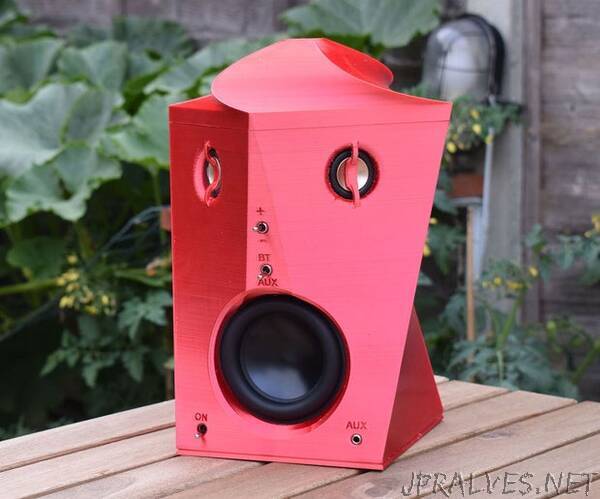
“My name is Simon Ashton and I have built many speakers over the years, usually from wood. I got a 3D printer last year and so I wanted to create something that exemplifies the unique freedom of design that 3D printing allows. I started playing with shapes and this is what popped out.
Say hello to Mr. Speaker! He is:
3D Printed
Stereo
Battery powered
Bluetooth
Active
DSP (flat response 45Hz - 20,000Hz and linear phase)
PHOTO - Click
Traditionally speakers need filter electronics to separate the signal for each driver and tune the sound. This can be a rather clumsy process involving large and expensive parts which nonetheless force the designer to choose many significant compromises.
Mr. Speaker makes use of a modern digital signal processor (DSP) the Analog Devices ADAU1401 to bypass many of the traditional design compromises. Only some years ago such processing was the remit of large professional speaker installations with a rack of dedicated equipment, but is now becoming increasingly accessible. This technology allows a designer unprecedented control over behaviour of the audio system for a final result that is as near perfect as possible - from deep bass to high treble.
I’m separating this instructable into two types of step; Build and Design.
Steps labelled (Build) are all you need to follow to make your own speaker.
The (Design) steps cover the process I went through to create Mr. Speaker. These steps are not necessary to build Mr. Speaker but I hope they will function as an educational tool to help learn about the fascinating subject of audio design.
Having uploaded this a few people have asked ‘How does it sound?’ Honestly amazing! I didn’t expect a 3D printed enclosure to be able to sound this good. You probably can’t tell from a video recorded on my mobile phone but here is a bit of example music!
Mr. Speaker Video - Click
Supplies:
Mr. Speaker is 3D printed, but you will need to purchase a few electronics parts to make him sing. I strongly recommend getting the exact same circuits I use to avoid unexpected problems.
I will provide a link for each item that I actually purchased. I am not sponsoring that specific seller, it is just to illustrate the part needed. You may prefer to purchase the same part elsewhere.
Aliexpress
ADAU1401 DSP Board (Signal Processing)
eBay
EZ-USB Programmer (Program the DSP memory)
TPA3118 Mono Amp Board (Woofer Amp)
TPA3110 Stereo Amp Board (Tweeter Amp)
14500 Batteries and Charger (‘AA’ sized batteries with high voltage and capacity)
4x ‘AA’ Battery Holder (Series connection for high voltage, not parallel. Sold as ‘6V’ for AA batteries)
5 Volt Regulator (To power bluetooth and DSP boards)
Speaker wadding
M3 4mm Button Screws
Bluetooth Module M28
Parts Express
Woofer 1pc - Dayton ND91-4
Tweeters 2pcs - Hi-Vi B1S (Alternative source Solen.ca)
RS Components
Source & Power Switch (2pcs, double pole, double throw, latching)
Volume Switch (single pole, double throw, momentary)
Aux Jack (3.5mm stereo)
Total cost should be approximately £125 GBP
You will also need basic tools like a soldering iron and some miscellaneous bits like glue and wire. And, of course, a 3D printer large enough (200x200x200) for example Ender3 plus PLA filament.
Update: I tested play time on one charge. Lasted about 3 hours.”
